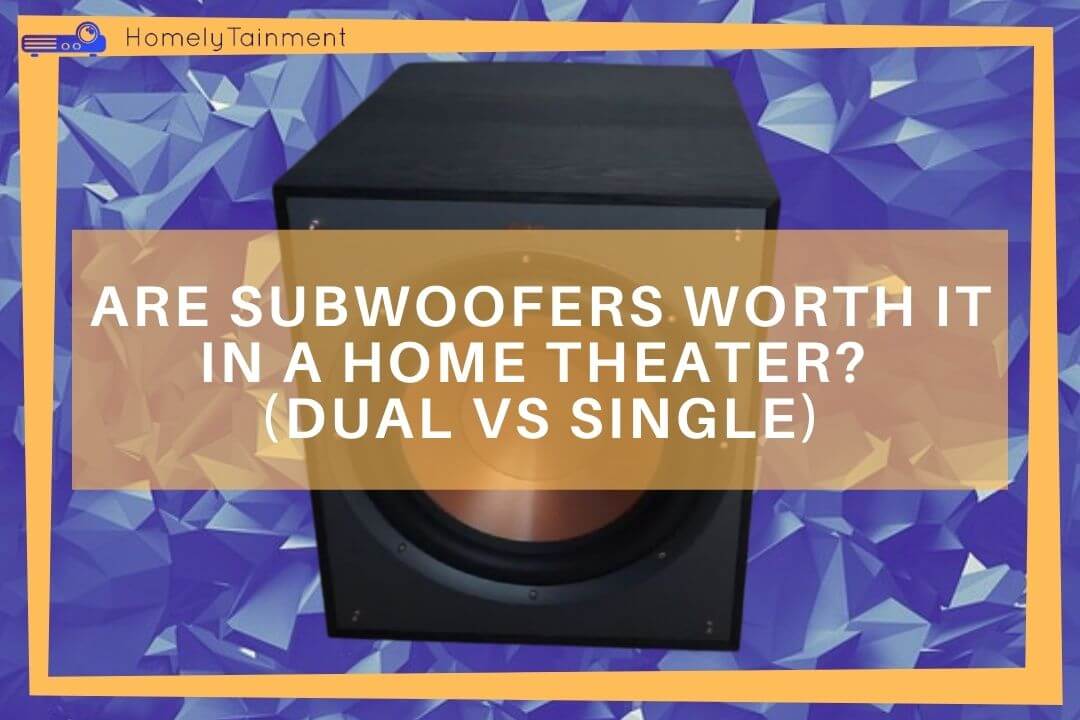
Homelytainment earn commissions (at no additional cost to you) if you purchase products from retailers after clicking on a link from our site.
For many home theater owners, sound plays a more significant role than video. A home theater is more about sound realism than visuals. Every speaker has a distinctive role in the sound signature. Each one is responsible for their assigned sound level creation. That’s where the subwoofer is having the role of bass creation. But are these subwoofers worth it?
At A Glance: The subwoofer gives that realistic touch to movies and songs. It produces the bass and bass directly affects the emotions and thoughts of us human beings. That’s why a subwoofer is absolutely worth it if you want that realism from your home theater.
Stick to the article as well will discuss many more aspects and the number of subs in the theater room. Also, don’t forget to discuss the poll results with me. I have conducted this poll in a home theater Facebook group.
What is the point of a subwoofer?
In-Short: There are many frequencies of sound in a home theater. These frequencies range from 14 Hz to 20kHz. Each speaker plays its own frequencies. The subwoofer plays the lower-end frequencies of 14 Hz to 39 Hz.
In-Depth: These lower frequencies carry the emotions and realism touches of music and movies. These low-end frequencies can’t be played by any ordinary speakers with normal drivers. These drivers are not manufactured to fire these low-end frequencies.
Like huge floor-standing speakers can’t go lower than 40Hz. These speakers usually have multiple drivers in them but still, they require the help of a subwoofer to play the frequencies below 40Hz.
That’s why the straightforward point of the subwoofer in a home theater is that it can play low-end frequencies that can’t be played by normal speakers.
Know about the best frequency response and crossover settings for home theater. Read my this guide you will know more about frequencies.
Do subwoofers make a difference?
In-Short: Without a subwoofer in the chain, there are dull emotions and no realism in the movies and music. That’s when a subwoofer is added, it can bring the difference of emotions and realism to the home theater.
In-Depth: Let’s share with you my real-life story. I installed an SVS subwoofer in my client’s home theater. I played a Gladiator movie.
When the scene of the arena fight came. My client turned to me and said, “Daniel! I am not there but my legs are shaking in fear”. This much realism and emotions a subwoofer brought to my client’s theater room.
He told me that he is enjoying movies way better than before. He added, “I was missing on so much bass before and I was unaware of it. There is more boom to the sound of the same movies and music I was hearing before”
I think now you have successfully understood through my real-life stories what difference the subwoofer brings.
Now, there is another very powerful debate in the home theater community. That is a single sub or dual sub. Which is better in a theater room? Let’s discuss it.
Read my guide about the best subwoofer for home theater. You will know which factors make the best sub.
Single Subwoofer in a home theater
A single subwoofer is a must to have in a home theater. This will fire those lower frequencies at you. But this is not the only answer for throwing bass in the home theater.
While a single sub is necessary for home theater, it will not always fill the entire room with a sub. Most of the time I experience bass dead points in my clients’ theater rooms.
A single sub can’t cover all the points of the theater room with bass. I don’t want to get into super technical words about it.
But understand it this way. A single sub-sound will travel in the room and will reflect from the walls. When these reflected sounds collide with newly generated sound by sub. These collisions will result in a huge spike or zero-bass points. These two points will be present throughout the room.
A bass dead point can be identified by crawling all over the theater room and marking the points where you are experiencing lesser or no bass.
In the presence of a single sub, you will have a bass in the room but the bass will not be smooth, cleaner, and tighter.
Where to place a single sub? I will recommend placing it in the middle of the center channel speaker and one of the front speakers. The sub should be directly facing your and should be 2-3ft away from the wall.
Get the complete guide of home theater speakers placement here from my this guide.
Dual Subwoofers in a home theater
The dual subwoofer can completely cover the whole theater room. You will get cleaner, smoother, more accurate, and tighter bass throughout the room.
When these subs have different frequency responses, they will create smooth bass with more accuracy. The bass will be felt at multiple points in the room.
I felt the vanishing of dead bass points in almost all of my clients’ rooms when they installed another sub.
When each sub in the pair has its unique frequency response, these frequencies will not collide in a way that will result in peak and null bass.
Also, two smaller subs are always louder than a single giant sub.
Dual subs also result in space management and are easy to install. You can easily carry two small subs from one place to another than a giant one. You can place the smaller subs easier than the giant ones.
How to install a dual subwoofer? As a general rule of thumb, they must be placed opposite each other. It should feel like they are going to fight with each other in a boxing ring. For if one sub is at the right corner the other sub should be at the opposite side of the room at the left corner.
In this arrangement, they will better fill the entire room. But you can have them both at the front as well for convenience. Each sub will reside in the middle of the center channel and one of the front left and right speakers.
If you are thinking of adding another sub then read my best budget subwoofer under the $500 guide. It will help you a lot.
How many Subs do you guys have in your home theater? (FB Group Poll)
| Survey | Poll Results |
|---|---|
| I have a single Subwoofer | 78.42% |
| I have dual Subwoofers | 21.58% |

Here the majority of users have a single sub in their home theater.
Those who voted for a single sub. By interviewing them, I concluded that the users who are using a single sub. They are having smaller rooms or most of them don’t consider a need for dual subs. They are unaware of the importance of having dual subs in a room. When I talked to them and told them about the importance and benefits of having dual subs. 80-82% of those who voted for single subs, were convinced to try dual subs.
Those who voted for dual subs. By interviewing them, I concluded that they were either experiencing dead bass spots in their theater room or they wanted to have the best bass possible in their home theater.
FAQs
Which is the better speaker or the subwoofer?
You can’t compare a speaker with a subwoofer. Each of them has its distinctive role in a home theater. That’s why you can’t say which is better because they don’t have one role to play.
Because speakers tend to play 40Hz to 20kHz and the subwoofer plays from 14Hz to 39Hz. The sub can go to 100 Hz but not recommended above that.
As you can’t compare an airplane with a car in the same manner you can’t compare a subwoofer with a speaker.
Is a subwoofer necessary for tv?
No matter whether you project a screen or you have a TV in your home theater room. You always need a subwoofer in the chain.
A single subwoofer is a must but a dual subwoofer will open a whole new world for you.
Do you need a subwoofer for music?
You need a subwoofer for music because there are a lot of frequencies in the music that can’t be played by normal subwoofers.
These lower frequencies are not the weights that can be lifted by speakers. You need a subwoofer for low-end frequencies from 39Hz to 14Hz to handle them.
Helpful Resources For The FAQs To Read More
- This was my opinion, read more about it from Klipsch Blog. (Resource for the first answer)
- This was my opinion, read more from this discussion on AVSforum. (Resource for the third answer




